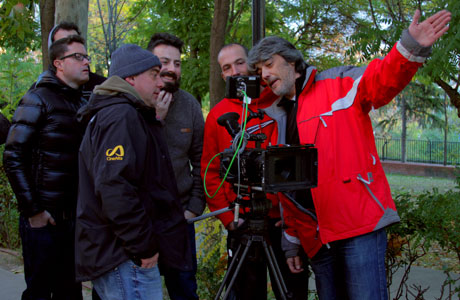Courses
Cinematographic lighting techniques course March 2014
Cinematography is an art but also a technique. You have to know the language of light to be able to transmit and know what is most appropriate for each project. But how to learn this language and thus be able to communicate with light?
In this course of cinematographic lighting techniques the student will learn the lighting techniques to be able to play with light knowing the basics of this discipline. From the properties of light to the classification of existing lighting equipment, with theoretical and practical classes, this course lays the foundations to learn the lighting language and its syntax. This introductory course is completed with the Lighting Styles course.
TEACHER: Rafa Roche
Rafa Roche, cinematographer specializing in digital cinema and stereoscopy is one of the leading figures in digital cinema in Spain. He is a member of the AEC and ACTV, Independent certified Expert of Sony and partner of Ars Stereoscopica. His more than 20 years of experience in the industry and the last 10 years working as a director of photography have led him to work in feature films, documentaries, television and advertising and to be one of the gurus of digital photography in Spain. A great communicator, he has developed his teaching skills in numerous centers and courses nationwide and through his own training project, Roche HD.
DURATION: 20 hours.
PRICE: 380€ (340€ if you book before March 23rd, we have extended the discount period). You can get up to 20% discount if you sign up for several courses. Discounts are not cumulative.
WHEN: From March 24th to 28th, 2014. The schedule is in the afternoon from 16h to 20h (may vary slightly).
WHERE: Campus Audiovisual Ces. See in Google Maps If you need any kind of information you can contact 709 MR by email or phone (668840783).
COURSE CODE: TDI13-240314
AIMED AT: Camera operators, lighting technicians and other members of the camera crew, directors, filmmakers and in general video and photography professionals who want to learn lighting techniques.
PREVIOUS KNOWLEDGE: Basic knowledge of cinematography and lighting.
EQUIPMENT USED
Sony F3
Sony lens set
Filter holder
Follow Focus
Batteries and charger
Feeder
Camera tripod
Waveform and Vectorscope Monitor
Full HD Image Monitor
Computer to dump the practices.
Camera card reader
Reflected photometer
Incident photometer
Sekonic L758 Cine Digital Master
Neutral gray letters
Color chart
Fresnell, fluorescence, Par, etc.
Tripods
Several ceferinos
Esticos
Racks
Gauze and silk set
Various filters
CONTENTS
DAY 1:
Basic concepts nature of light. Electromagnetic spectrum and visible spectrum. Properties of light: Reflection, Refraction, Absorption, Transmission, Interference, Diffraction, Polarization.
Photometric units: Intensity, luminous flux, illumination, luminance, reflectance, transmittance.
Color: Color temperature. Mired deviation value. Grassman’s laws. Trichromatic equations. International color triangle. Standard sources. Color spaces.
Electricity basics: Alternating and direct current. Three-phase distribution. Power, voltage, resistance, power distribution.
Classification of currently existing lighting equipment.
DAY 2:
Digital cameras: basic concepts about:
Lenses
Sensors
Depth of field
Gamma curves
Color space and matrix
Raw
Waveform and Vectorscope Monitor
Photometers: Incident and Reflected. New photometers for digital cameras. Utilization.
Thermocolorimeter: Bicolor and tricolor. Use.
DAY 3:
Description of equipment:
Electrical distribution, switchgear, Cetac, Shuko
Tripods, mounting systems, accessories.
Projectors:
Tungsten
PAR
HMI
CinePar
Fluorescence
Frames, lungs, banners, gauze, silks
Palios: assembly of a palio, comparison of different fabrics.
Assembly of the equipment:
HMI 18/12Kw
HMI 6Kw
Minutes
Fresnell 10 Kw
Mobiles
DAY 4:
Practical lighting.
Lighting triangle: Main, fill and contra light.
Double contra. Wrap-around contra
Hard light and soft light. Light diffusion and effect. Diffusers, frames, scopes, canopies.
Cuts and modulation of light, cinefoil, flags, gauze, silks
DAY 5:
Programs and solar curves.
Practical Outdoor Lighting
Color correction: basic concepts.
Color correction of practices (basic)
The student will be able to take all the video material generated during the course on a personal hard disk.
All course practices must be carried out by the students, who will be responsible for setting up and configuring the camera and lighting equipment under the supervision of the course instructor.
You can download the documentation for the course here
For any further information please contact us at info@709mediaroom.com.


